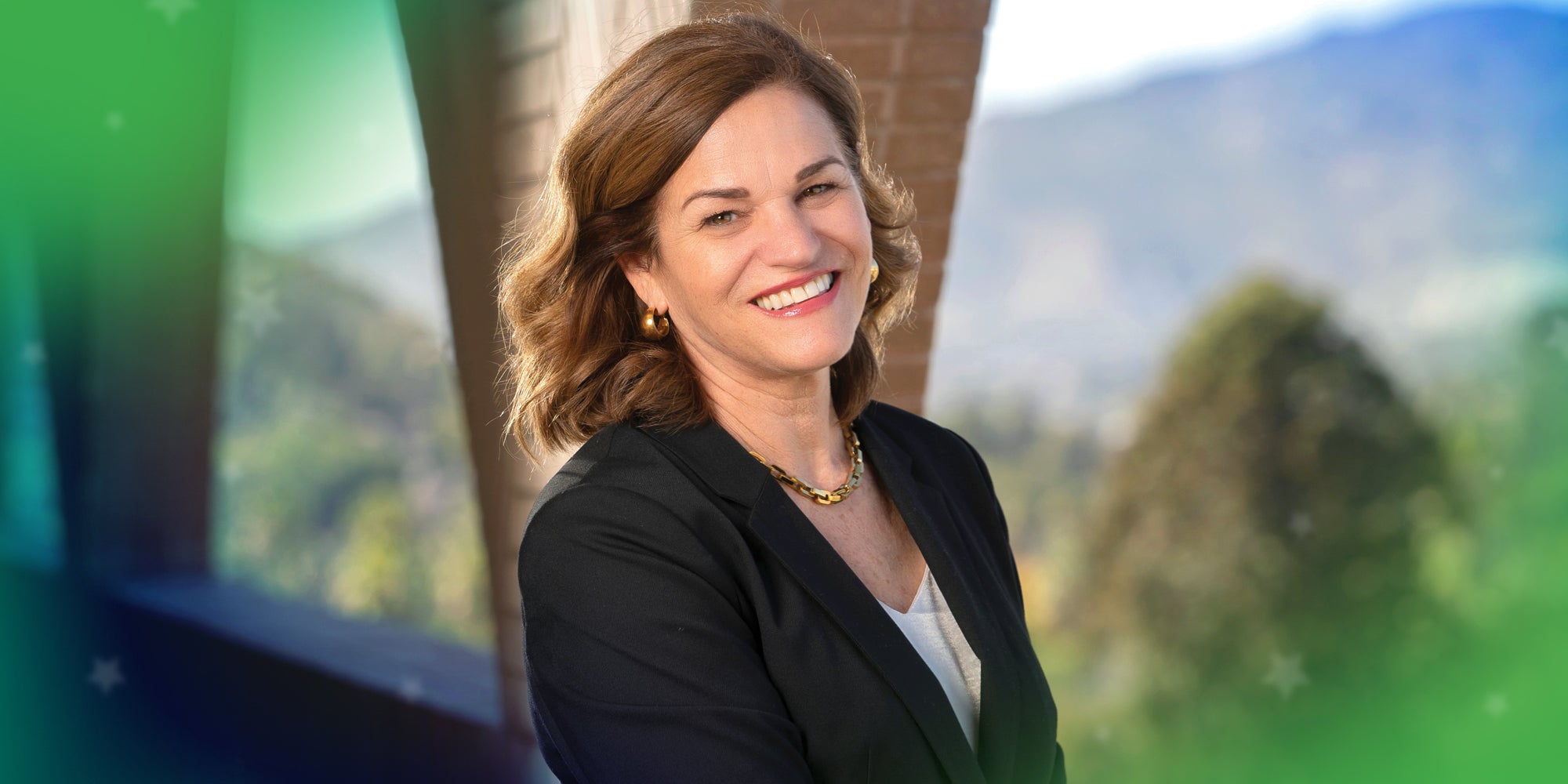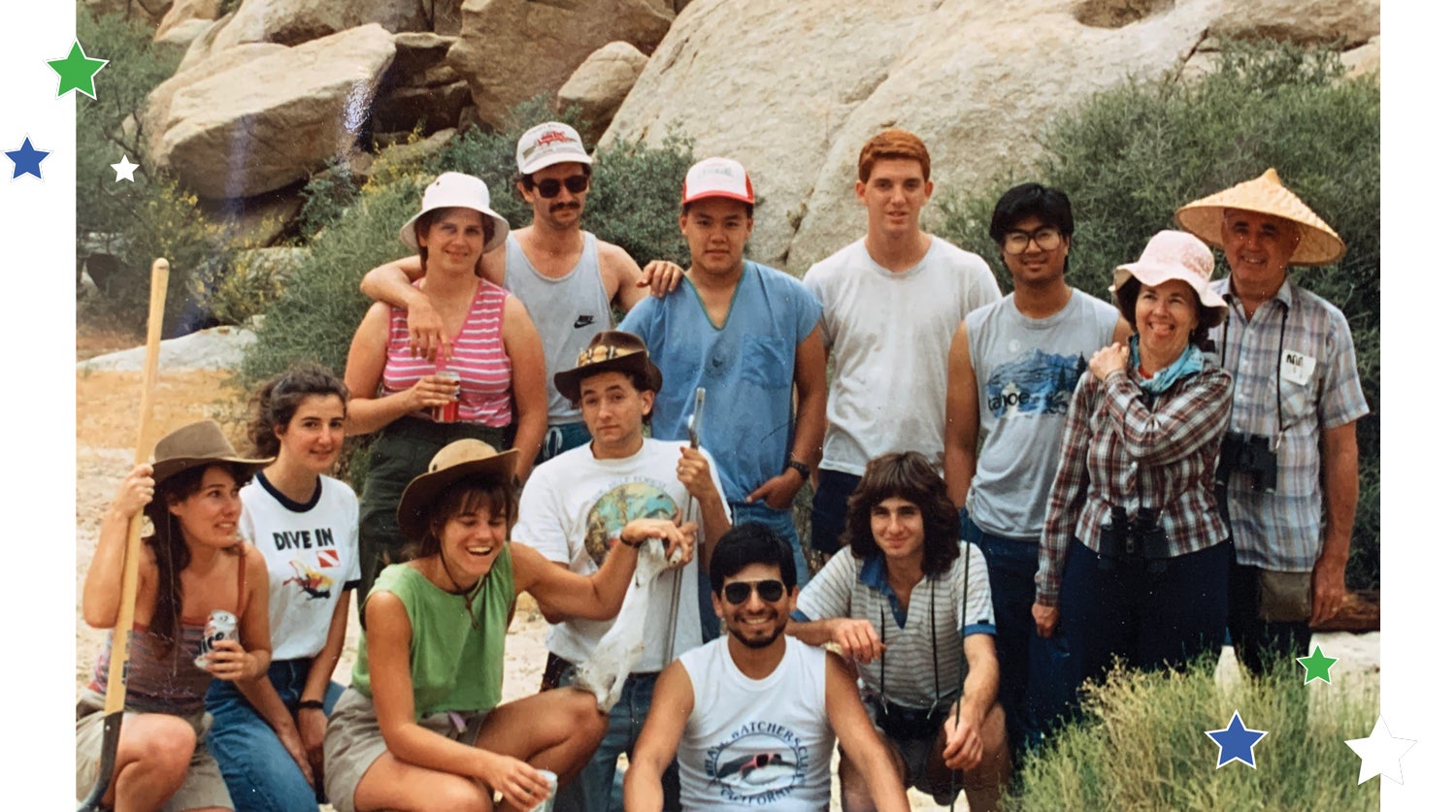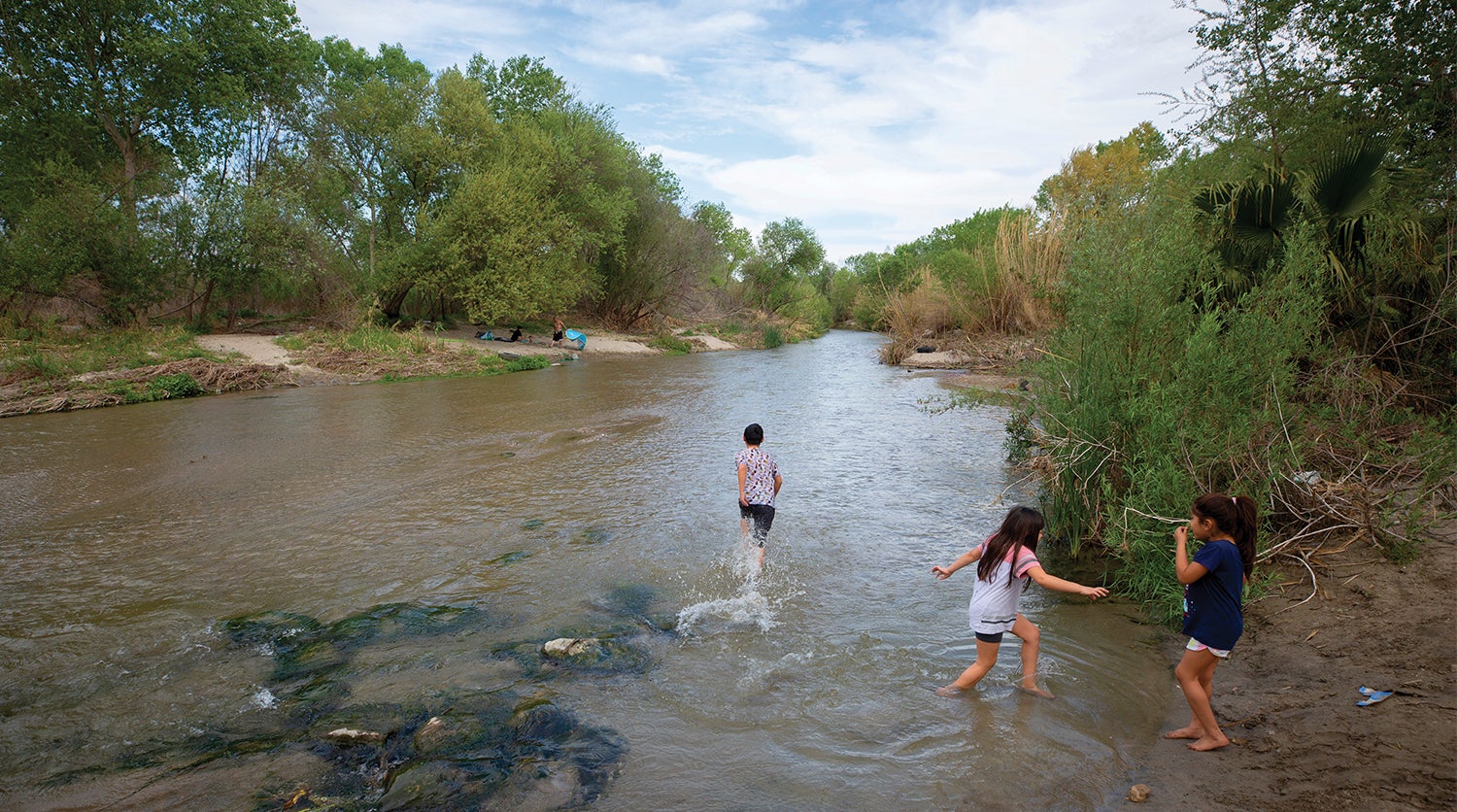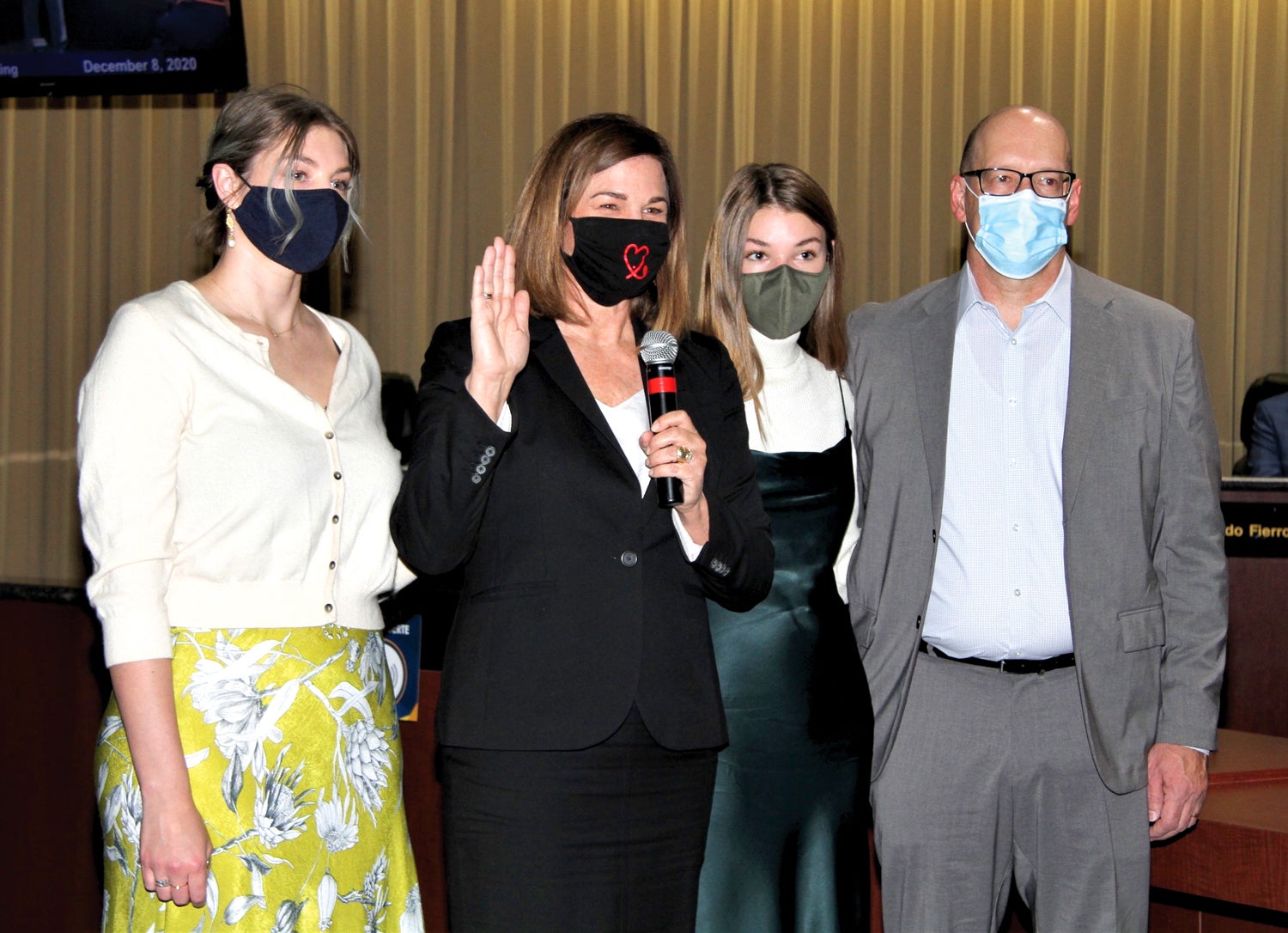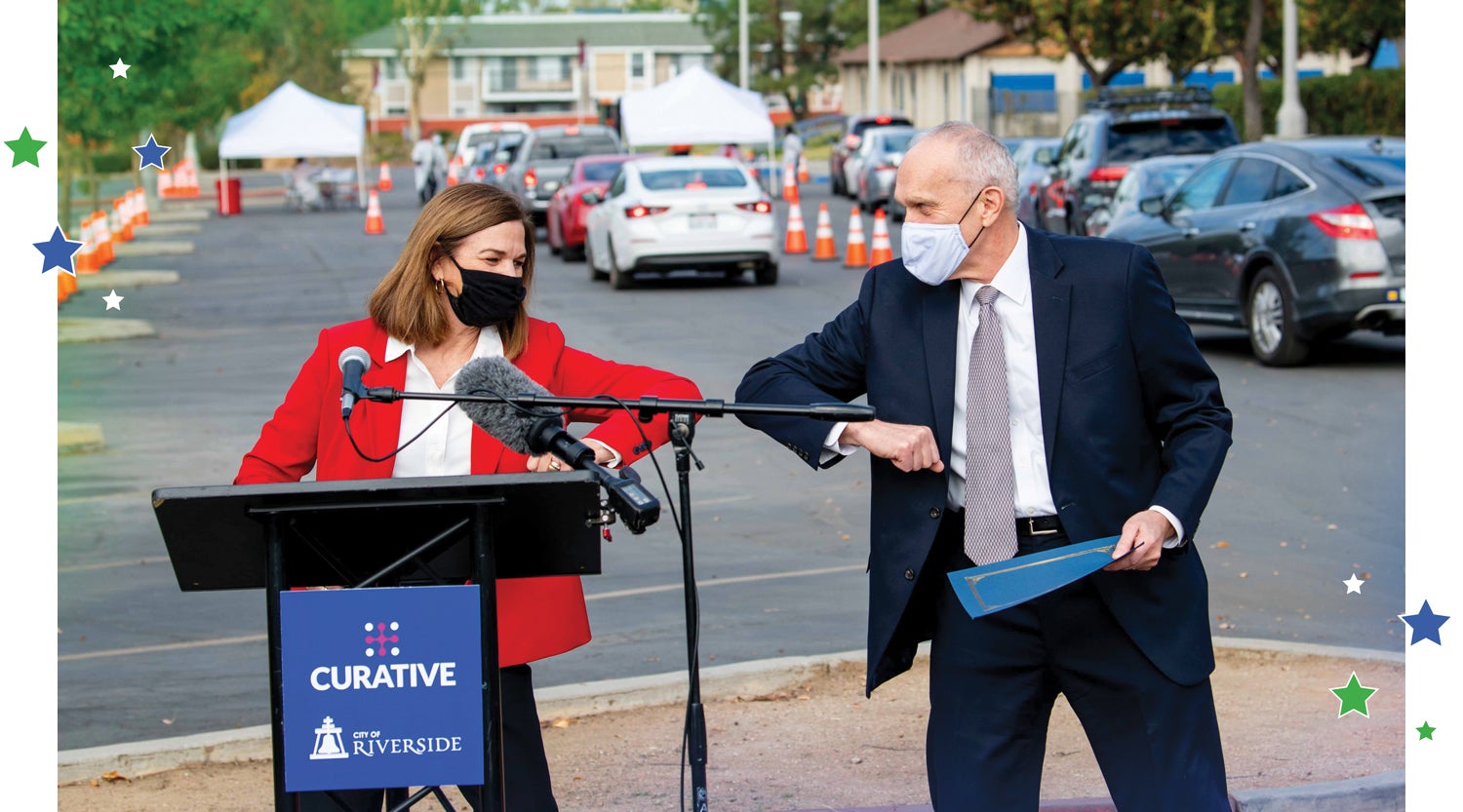Patricia Lock Dawson '88 at Riverside City Hall. (UCR/Stan Lim)
HOMECOMING
Riverside Mayor Patricia Lock Dawson ’88 felt an urge to come back and serve the city she loves.
By Omar Shamout
the late 1860s, a lawyer named John W. North of Knoxville, Tennessee, persuaded a group of friends to pay $1,000 each to purchase 8,600 acres from an ill-fated silk-growing colony east of the Santa Ana River in an area first inhabited by the Cahuilla, Tongva, Luiseño, and Serrano peoples. Part of that land would become incorporated as the City of Riverside in 1883, with its charter adopted in 1907. Two years later, Samuel Cary Evans Jr., the son of the richest man in Riverside, was elected as the city’s first mayor. It took nearly 90 years for a woman to be elected to that role, and another 30 years for the second. That woman, Patricia Lock Dawson ’88, is also the first graduate of UC Riverside — or any of the city’s three universities — to hold the honor, and she leads a city that now has 326,000 residents, the 13th largest in the state.
“Changing that shortfall in connectivity between the City of Riverside and the institutions of higher education is one of my top priorities,” said the 56-year-old Lock Dawson, an environmental scientist and Riverside native who was sworn into office on Dec. 8, 2020, after defeating Andy Melendrez by a margin of 59% to 41% in the November general runoff election.
She previously served as a trustee on the Riverside Unified School District for nine years. Besides public service, Lock Dawson’s career has been driven by her love of the outdoors, which was instilled during childhood by her mother, who wouldn’t let her watch TV during the week. This spurred Lock Dawson and her four older siblings to spend much of their days running through the city’s orange groves and playing around the Gage Canal, which was built in the 1880s to irrigate the then-fledgling city. Her passion for nature was fostered at UCR, where she followed in the footsteps of her brother Robert ’76 and sister Barbara ’84. Her most joyful experiences came under the tutelage of Wilbur Mayhew, a former biology professor — and architect of the U.S. Natural Reserve system — who would often take his students on field trips.
“We went camping on the weekends, and I just fell in love with it,” Lock Dawson said, “So many of my good memories were from those trips. Dr. Mayhew was just a delight. I thought I was going to medical school. I changed my whole major based on that.”
But not all of her favorite memories have to do with academics. Lock Dawson and her friends — she still talks to Douglas Long ’88, a collection specialist at the Museum of Riverside — often hung out at The Barn and attended a number of shows at the once-thriving live-music venue, including gigs by The Salvation Army and Bill “The Fox” Foster, a performer known for singing bawdy songs and chugging beer — he could down a 40-ounce pitcher in about 3.5 seconds. Her other favorite haunts were The Pub, a former coffee house on campus; Getaway Cafe precursor The Bull and Mouth; and the Fiji house.
“There were some pretty legendary parties” at the fraternity, she recalled. After receiving her bachelor’s degree in biology, Lock Dawson spent a summer at Bryce Canyon National Park in Utah as a national park ranger, where she met her husband, Scott. She went on to earn a master’s in wildlife ecology from the University of Washington. After graduate school, in 1992, she and Scott went back to Utah after she got a job working for the state’s Department of Natural Resources as a wetlands coordinator, a role that combined both research and policy. Two years later, the couple moved back to Riverside after they both got new jobs, he as an environmental scientist for the California Regional Water Quality Control Board, and she as a wildlife biologist for the U.S. Bureau of Land Management.
“When I was working for the bureau, I realized I was a pretty good wildlife biologist, but I was a much better policy maker,” Lock Dawson said. “I ended up getting pulled into all sorts of policy discussions regarding land management, and I realized I could actually have a career in politics and public service that way.”
But as often happens, life got in the way. Four years later, she and Scott had their first child, Clara, and her priorities changed. “I realized I didn’t want to work full time anymore,” Lock Dawson said. “I wanted to focus on my family.”
Lock Dawson, bottom row center, during a 1988 camping trip with Wilbur Mayhew’s UCR field biology class.
The Santa Ana River
When colleagues suggested she do some consulting work in 1999, her company PLD Consulting was born to assist organizations and public entities with land use, governmental affairs, and strategic planning. Buoyed by her experience and skill in crafting policy, Lock Dawson began a five-year stint as a commissioner on the Riverside Planning Commission in 2007, helping oversee the rehabilitation of the Fox Theater and construction of the La Sierra Library. She also saved the Stalder Building from demolition, among other accomplishments. Riverside County Supervisor John Tavaglione and Mayor Ron Loveridge were impressed with Lock Dawson’s work on the planning commission and asked her to assist with conservation efforts related to the Santa Ana River, California’s longest waterway, which flows nearly 100 miles from its northernmost reaches at the crest of the San Bernardino Mountains, traveling through Riverside and out to the coast near Huntington Beach.
In 1990, the U.S. Environmental Protection Agency placed the Santa Ana on its national list of toxic rivers due to decades of industrial pollution. It was described by the Los Angeles Times a year later as “more a source of ridicule than recreation, more of a waste pit than a resource.” Through Lock Dawson’s efforts, the Santa Ana River Trust was founded in 2011 to inspire new ways of restoring the river to its original glory and preserving it for future generations. Three years after that, the state legislature created the Santa Ana River Conservancy Program, which addresses open space, trails, wildlife habitat, agricultural land and water quality protection, educational use, and public access in the Santa Ana River region. She has brought to Riverside more than $50 million for work on the river, largely from state and federal funding.
Kids play in the Santa Ana River in Riverside. Lock Dawson’s efforts have helped preserve the waterway. (UCR/Stan Lim)
“It became obvious there needed to be an organization that took care of the river. It was a very important action,” said conservationist Jane Block, one of Lock Dawson’s most trusted mentors and a founding member of Riverside’s Rivers and Lands Conservancy, on whose board Lock Dawson has sat since 2011, including as president from 2014-17. “The Santa Ana River was one of the first rivers that had environmental protection around it, so it was an example for others.”
Block, who is married to retired UCR math professor Richard Block, also served on the committee that led to the founding of the university’s Women’s Resource Center, and she advocated for the creation of the Center for Conservation Biology. She said Lock Dawson’s pragmatism and diligence have helped the conservancy accomplish many of its goals.
“Patricia has always brought to the organization a commitment to science and an understanding of process that I think comes from her educational background,” she said. “That has been very valuable.”
Loveridge, a professor of political science at UCR, also credited Lock Dawson with helping to push the project through.
“I thought she was really quite magnificent in her ability to work with staff and elected officials, and to sort through complexities of regional governance,” said Loveridge, who served as mayor from 1994 to 2012, the longest tenure in city history.
Time to Run
Lock Dawson began eyeing elected office herself when her third child, Martha Rose, started elementary school. At the time, there were no parents of school-aged children on the school board.
“I had a child in all three levels of Riverside Unified School District: elementary, middle, and high school,” she said. “I believed it was important to have the voice of a parent at the table.”
She was elected as a trustee in 2011 and served until becoming mayor. During her tenure, the board identified low graduation and college attendance rates among Black students as the district’s biggest problem — about 6% of the district’s roughly 42,000 students in 2019-20 were African American. The board implemented the Heritage Program in 2013 as a way to offer additional support for this population. District-wide graduation rates rose from 81% to 97% over the next seven years, with college-going rates climbing from 33% to 46% among Black students.
In 2019, Loveridge and then-mayor Rusty Bailey separately came to Lock Dawson and asked her to run for mayor — she and Loveridge still speak by phone about once a week. Of the 482 incorporated cities in California, only five — San Diego, Los Angeles, Fresno, Oakland, and San Francisco — have a “Strong Mayor” form of city government, in which the elected mayor carries executive authority over all city policies and operations. For the remaining 477 cities, Riverside included, the role of the mayor is largely ceremonial, though constituents often view them as responsible for all city activities.
Lock Dawson with her husband Scott and children Martha Rose, left, and Clara at her swearing-in ceremony on Dec. 8, 2020, in the Riverside City Council chambers.
“There are two primary roles that a mayor has in a council-manager form. One is to be a facilitator — to foster collaboration with council members, with the city manager, with the community, with outside groups,” Loveridge said. “The other is to bring a vision, to be able to identify priorities and direction. Patricia can readily do both.”
Lock Dawson’s thoughtful, diligent leadership style — she’s not a fan of excessive meetings — is grounded in her scientific background and love of data. This represents a departure from Bailey, who often relied on his larger-than-life personality to accomplish objectives.
“I like to be strategic about everything I do,” Lock Dawson said. “Having a science background is really important as a decision maker … because we tend to be critical of the information that’s given to us. I don’t think there’s enough of us.”
When thinking about her role as only the second female mayor in the city’s nearly 150-year history, Lock Dawson said she considers it significant not only for women, but for all underrepresented groups, and she wants them to know that everyone has a voice.
“It is greatly important to have female leaders,” she said. “Studies have shown that when women are in elected office, they are bridge-builders to other underrepresented groups, which in turn uplifts all communities.”
Lock Dawson and Chancellor Kim A. Wilcox at the opening of the UCR COVID-19 testing site on Dec. 17, 2020.
(Courtesy of City of Riverside)
A New Oasis
While the pandemic complicated the latter part of Lock Dawson’s campaign and has consumed the first few months of her term, her work on combating homelessness, building sustainable infrastructure, creating jobs, and revitalizing the downtown area, to name a few issues, continues at City Hall and from her home office in the Canyon Crest neighborhood, from which she worked about half the time during the pandemic until Riverside County moved into California’s red coronavirus tier in March. The mayor sees UCR as a vital partner in accomplishing many of those goals. Perhaps most notably, the city is working with the university to create a sustainability innovation park known as OASIS, modeled on UC San Diego’s research park, which will aim to produce startups focused on solving environmental and agricultural challenges while creating jobs in Riverside and neighboring counties.
The proposed project would be part of the city’s Innovation District, a 3-square-mile zone near UCR anchored by the California Air Resources National Board’s new 380,000-square-foot headquarters, which will be one of the largest and most advanced vehicle emissions testing and research facilities in the world thanks to pacts with UCR and other local schools. OASIS would boost the efforts of several UCR entities including the ExCITE business accelerator, Entrepreneurial Proof of Concept Center — Small Business Development Center, and the Marlan and Rosemary Bourns College of Engineering Center for Environmental Research and Technology to generate a pipeline of sustainability-focused startups by providing mentorship, access to industry experts, test facilities, and funding.
“The Inland Empire has long served the nation by promoting innovations in air quality research, agriculture, natural resources, clean logistics, and climate change,” said UCR Chancellor Kim A. Wilcox. “Many of these innovations have been developed to address pressing challenges facing the region. OASIS will build on this legacy by leveraging investments and relationships involving public, private, and philanthropic partners.”
Lock Dawson said the continued revitalization of the downtown area would also help attract students and skilled professionals to Riverside.
“We want to help provide a better diversity of food and entertainment options for our students, and work to develop job pipelines and internships between employers and the university, so we don’t lose them to other areas,” she said. “Additionally, through the Innovation District and UCR’s Highlander Venture Fund, we want to support fantastic business ideas and patent development, so we can grow an ecosystem of businesses right here from UCR.”
This is more than just a professional goal for Lock Dawson — it’s a personal one. Coming from a family where all of her siblings had to leave Riverside to fulfill their dreams, she and her husband made a conscious decision to come back to the city to build their family and careers. It’s also why she decided to run for office, beginning with the school board and now as mayor.
“I just thought, if I’m going to be here, I’ve got to work for my kids to be able to stay here and have the opportunities that my brothers and sisters left town for,” she said. “That’s how I got on the planning commission. That’s how I ran for school board. That’s how I ran for mayor, by continually working for a community where people feel like they have opportunities and those opportunities are limitless.”
